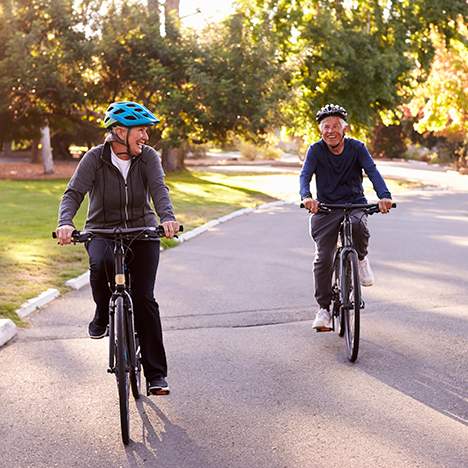According to the Bicycle Helmet Institute, as of January 2021, bicycle injuries have increased by 21% in people over 40 years old. The number of bicycle deaths in the U.S. also continues to rise with over 850 annual deaths, compared to 665 in 2002.
Bicycling laws apply at the city, county and state level, and can differ by location. It’s important to know how these laws impact cyclists, as not every vehicle or pedestrian will know the bicycle laws, bylaws, and etiquette of the road. Here are a few of the most common questions that people have when it comes to the legal rules of the road:
What are the rules for riding a bike in California?
Cycling laws in California fall under the California Vehicle Code (CVC) and vary depending on where you are biking. For example, biking on highways is state law but rules around biking on sidewalks fall under city or county law.
According to the California Bicycle Coalition, it’s best to think of your bike as if it were a motor vehicle. This means if you’re driving as fast as other motor vehicles, you’re allowed to behave as if you were a car. When you’re traveling slower than traffic, California bike laws stipulate that you must yield to drivers by staying close to the curb and always ride with the traffic flow — never against it.
Do you have to wear a bike helmet in California?
The California bicycle helmet law applies to anyone under 18 years of age, and includes children riding in a bike seat or being towed by a bike trailer. All helmets must be approved by the American Society for Testing and Materials, or the United States Consumer Product Safety Commission (CVC 21212). The fine for anyone under 18 not wearing a helmet carries a maximum fee of $25. Although it’s legal for anyone over 18 to not wear a bicycle helmet, wearing a properly fitted helmet is always recommended for safety purposes.

Are there cycling at night laws?
Bicycle light regulations fall under state law (CVC 21021), and the colors of the reflectors and the lamps or lights are important. Like a motor vehicle, white lights or lamps are required for the front of the bike and must be visible from 300 feet. Red lights or reflectors are required for the back of the bike and must be visible from 500 feet. White or yellow reflectors are also required on the pedals and wheels of the bike to increase visibility from the back and sides of the bicycle. It’s also encouraged to wear reflective or bright coloured clothing when biking at night.
The colors of the lights also fall under state law. White, red and yellow lights, and/or reflector are the legal colors a bicycle can display. It’s illegal to display a steady or flashing blue light, as that is reserved to identify emergency and police vehicles.
Is riding a bike on the sidewalk illegal in California?
Laws for biking on sidewalks are determined by the city or county, not necessarily the state. For example, when cycling in Los Angeles, it is legal to bike on the sidewalk. The stipulation is that the cyclist needs to respect pedestrians and not bike “with a willful or wanton disregard for the safety of persons or property” (LAMC 56.15). Los Angeles bicycle laws also depend on the district you’re riding in. It is illegal to ride on the sidewalk at any time within a designated business area, but it’s okay in residential neighbourhoods.
Is it legal to operate a bike while under the influence of drugs or alcohol?
Rules for riding a bike in California on highways fall under the California Vehicle Code. Bicyclists are subject to the laws of driving a vehicle while on a highway — including drinking and driving. However, instead of potential jail time, there is a maximum $250 fine. Operating a bicycle under the influence of drugs or alcohol is dangerous, however, and should be avoided at all cost.
What should I do if I’ve been injured in a bicycle accident in California?
Road laws are designed with the intention of keeping people safe. Though it’s important for any cyclist to know the rules of the road, there is always a risk that nearby drivers will not follow their own applicable laws. After contacting the appropriate authorities and receiving the necessary medical attention, bicycle accident victims should speak with an injury lawyer in order to pursue compensation for their injuries.
If you’ve been injured in a bicycle accident due to the negligible actions of another party, we may be able to help. The attorneys at Avrek Law have more than 50 years of combined experience successfully resolving personal injury cases. With Over $2 Billion recovered in over 45,000 cases, our team is here to help – call today for a free bicycle accident case evaluation!
